A Review of Deep Learning in Rotating Machinery Fault Diagnosis and Its Prospects for Port Applications
Abstract
1. Introduction
- A systematic overview framework for port fault diagnosis applications is proposed. This paper goes beyond the traditional “model introduction—application case” paradigm and constructs a progressive discussion structure of “methodological basis—general component verification—port scenario challenge analysis—system deployment path”, which provides a complete guide from theory to practice for the implementation of deep learning technology in port equipment.
- This paper provides a comparative analysis of multidimensional and insightful deep learning models. This paper is not limited to the common accuracy comparison but constructs a qualitative and quantitative comparison framework from the core principles, applicable data types, calculation efficiency, noise resistance and port application potential and other dimensions, providing a profound decision-making basis for model selection under the port scene.
- This paper realizes the deep integration of deep learning and port diagnosis scenarios and systematically analyzes the domain-specific challenges. For the first time, this paper systematically identifies and deeply analyzes the core bottlenecks caused by the “high reliability paradox” of the port, such as data scarcity, model robustness under dynamic adverse conditions, and interpretability requirements under multi-system coupling and safety requirements and sorts out the corresponding adaptive technology path.
- A clear implementation path of system level project is outlined. This paper fills the practical gap from algorithm prototype to industrial system integration and discusses in detail the “cloud edge end” collaborative architecture, the integration scheme with SCADA/ERP and other port management systems, as well as the standardized deployment process, providing a clear road map for the industrial transformation of the research results.
2. Literature Review Methodology
2.1. Literature Search Strategy
2.2. Inclusion and Exclusion Criteria for Literature
2.3. Literature Search Process
2.4. Literature Quality Assessment
3. Basic Architecture of Deep Learning Models
3.1. DBN
3.2. CNN
3.3. AE
3.4. RNN
4. Signal Preprocessing and Feature Extraction for Deep Learning
4.1. Signal Preprocessing Methods
4.2. Feature Extraction Technology
4.3. Time-Frequency Analysis Method
4.4. A Fusion Paradigm of Time-Frequency Analysis and Deep Learning
4.5. Feature Selection and Dimension Reduction
4.6. Special Considerations for Port Equipment
5. Applications of Deep Learning in the Field of Fault Diagnosis
- (1)
- After processing signal data, deep learning methods are utilized to reveal the intrinsic features of the data, thereby avoiding errors from manual selection. After feature selection, widely adopted fault diagnosis techniques are applied to partially optimize diagnostic outcomes.
- (2)
- Following signal data processing, deep learning methods are applied separately to data with low and high correlation for feature selection. This approach significantly simplifies the process and reduces computational load.
- (3)
- Collected signals are imported into a predefined model to output desired target results. Through feature selection learning and result classification during the process, the entire workflow is simulated and learned. This approach reduces complexity and minimizes errors, enabling comprehensive optimization across all steps. However, it may increase computational load and potentially impact model generalization.
5.1. Diagnostic Methods and Application Potential of DBNs
5.1.1. Fault Diagnosis Method Based on DBN
5.1.2. Diagnostic Potential of DBN in Port Equipment
5.2. Diagnostic Methods and Application Potential of CNNs
5.2.1. Fault Diagnosis Method Based on CNN
5.2.2. Diagnostic Potential of CNN in Port Equipment
5.3. Diagnostic Methods and Application Potential of Auto-Encoders
5.3.1. Fault Diagnosis Method Based on Auto-Encoder
5.3.2. Diagnostic Potential of Auto-Encoder in Port Equipment
5.4. Diagnostic Methods and Application Potential of RNNs
5.4.1. Fault Diagnosis Method Based on RNN
5.4.2. Diagnostic Potential of RNN in Port Equipment
5.5. Comparative Analysis and Discussion of Four Deep Learning Models
5.5.1. Multi-Dimensional Performance Comparison Analysis
5.5.2. Discussion on Model Selection Based on Comparison
6. Core Challenges and Breakthrough Pathways for Intelligent Diagnostics of Port Equipment
6.1. Challenges and Countermeasures at the Data Level
6.1.1. Data Characteristics and Core Challenges of Port Equipment
- (1)
- The extreme scarcity of failure data and the “high reliability paradox”: As high-value, high-reliability assets, core port equipment (such as quay cranes and yard cranes) undergoes exceptionally stringent design, manufacturing, and maintenance standards, resulting in an inherently low failure rate. This creates a fundamental contradiction with the deep learning model’s requirement for a large volume of failure samples, thus forming the “high reliability paradox”: The events we most urgently need intelligent diagnostics to prevent are precisely those that occur extremely rarely but carry catastrophic consequences—and it is precisely for these events that data is the scarcest.
- (2)
- Professional Barriers and High Costs of Data Annotation: The operational states and failure modes of port equipment are complex, requiring deep involvement from domain experts (such as senior maintenance engineers) to accurately annotate data samples. This annotation process, heavily reliant on scarce expert knowledge, is time-consuming, labor-intensive, and costly, making the construction of large-scale annotated datasets extremely challenging both economically and practically.
- (3)
- The inherent extreme imbalance in data categories: throughout a device’s entire lifecycle, it spends the vast majority of time in normal operating conditions, while abnormal and failure states account for an extremely small proportion. This imbalance results in collected datasets where “normal” samples may outnumber ‘fault’ samples by several orders of magnitude. Training models directly on such datasets causes them to learn patterns from the dominant class, leading them to predict nearly all inputs as “normal” to achieve high overall accuracy—while possessing virtually zero actual fault detection capability.
6.1.2. Cutting-Edge Technical Approaches to Addressing Data Challenges
6.2. Environmental Challenges and Countermeasures
6.2.1. The Mutual Influence Between Environmental Harshness and Data Quality
6.2.2. The Challenge of Dynamic Operation Modes on Model Robustness
6.2.3. Advanced Requirements for System Complexity and Safety Criticality
6.3. System Deployment Engineering Path
6.3.1. System Architecture and Recommendations of Hardware Configuration
6.3.2. Real-Time Processing Challenges and Performance Optimization
6.3.3. Integration with Port Management Systems
6.3.4. Standardized Deployment Workflow
6.4. Future Pathways for Technological Development
6.4.1. The Unique Characteristics and Core Challenges of Port Equipment
- (1)
- The primary challenge stems from its extremely complex and dynamic operating conditions. Unlike the constant rotational speeds and loads found in laboratory settings, a single operational cycle of a ship-to-shore crane involves drastic load fluctuations, frequent starts and stops, and high-speed impacts. This results in vibration signals exhibiting pronounced non-stationarity and non-Gaussian characteristics. This dynamic nature renders diagnostic models trained under single stable conditions highly prone to misinterpretation, often mistaking normal operations for faults. Consequently, false alarm rates remain persistently high, severely undermining the model’s field credibility.
- (2)
- Secondly, the harsh operating environment and deep background interference pose significant challenges for feature extraction. The high-salt, high-humidity conditions at port sites not only accelerate mechanical corrosion but also directly impact sensor measurement accuracy and lifespan. More critically, intense environmental noise (such as sea winds, wave surges, and operational sounds from adjacent equipment) combined with electromagnetic interference can completely drown out or distort the key feature signals that characterize early, subtle faults. This demands that deep learning models possess robustness and noise resistance beyond laboratory standards, enabling them to perform robust feature learning that “separates the wheat from the chaff.”
- (3)
- A deeper challenge lies in the port equipment’s nature as a complex, multi-subsystem, tightly coupled system. A localized failure (e.g., bearing wear in a hoisting mechanism) can trigger chain reactions, manifesting as multimodal symptoms like structural vibration anomalies, hydraulic pressure fluctuations, or altered motor current characteristics. This multi-source coupling and propagation effect of failures renders “isolated” diagnostic models—designed for single components or single failure modes—ineffective. This necessitates a diagnostic framework with a system-level perspective [129] capable of understanding and analyzing dynamic interdependencies between subsystems, enabling precise fault tracing and isolation.
- (4)
- Ultimately, all these technical challenges converge under the essential constraints of reliability and cost-effectiveness for engineering implementation. Port equipment downtime carries extremely high costs and critical safety implications, which dramatically magnifies the drawbacks of deep learning models’ “black box” nature. The lack of interpretability in the decision-making process makes it difficult for field engineers and managers to understand and trust the model’s diagnostic results, thereby hindering their use in guiding actual maintenance decisions. Therefore, enhancing the model’s interpretability and reliability—ensuring its outputs are not only accurate but also “trustworthy”—is key to achieving technological implementation.
6.4.2. Future Research Directions and Pathways for Convergence Development
- (1)
- Cross-Domain Adaptive and Robust Model Learning: The core objective is to enable models to “learn to ignore operating conditions and focus on faults.” Future efforts should prioritize the development of deep transfer learning and domain adaptation algorithms. By leveraging richly annotated laboratory data (source domain) and employing techniques such as feature distribution alignment and adversarial training, models can overcome distribution discrepancies caused by drastic variations in port field conditions (target domain). This approach achieves robust diagnostics across operating conditions, fundamentally resolving the challenge of model generalization.
- (2)
- Multi-source Information Fusion and Digital Twin-Driven Diagnostics: It is imperative to overcome reliance on single vibration signals and establish a multi-source heterogeneous information fusion diagnostic framework based on digital twins. By integrating multi-modal data including vibration, acoustics, current, stress, video, and even maintenance logs, the real-time status of physical equipment is faithfully mapped in the virtual space. Within this framework, deep learning models perform multi-evidence collaborative reasoning to comprehensively evaluate and precisely locate complex coupled faults, elevating diagnostics from the “component level” to the “system level.”
- (3)
- Lightweight Design and Edge Intelligence Deployment: To address on-site computing bottlenecks, lightweight model design tailored for edge computing must be pursued. Research encompasses model pruning, quantization, knowledge distillation, and efficient neural network architectures (such as separable convolutions) to significantly reduce model size and computational overhead while preserving performance. Building upon this foundation, a cloud-edge collaborative intelligent operations framework is established: the edge handles real-time, lightweight anomaly detection and early warning, while the cloud manages model updates, big data analytics, and remaining lifespan prediction, enabling optimized allocation of computational resources.
- (4)
- Explainable AI and Physical Mechanism Embedding: Overcoming the “Black Box” Dilemma is Key to Gaining On-Site Trust. On one hand, actively introduce explainable AI (XAI) technologies, such as visualizing key signal segments underlying model decisions through attention mechanisms, or employing post hoc explanation methods like SHAP and LIME to provide logical justification for diagnostic conclusions. On the other hand, a more fundamental approach lies in exploring Physical Information Neural Networks (PINNs) [130]. By embedding physical prior knowledge—such as equipment dynamic equations and characteristic fault frequencies—as constraints during model training, the outputs become both data-driven and physically compliant. This gives rise to a next-generation diagnostic model that truly “understands both the what and the why.”
7. Discussion
- Ultra early weak fault detection technology. How to achieve high reliability and low false alarm detection when the characteristic signal is completely submerged by strong background noise in the embryonic stage of fault is the difficulty and frontier of current research.
- Unsupervised and self-supervised fault detection paradigms. In view of the fact that the normal state data of the industrial site is far more than the fault data, how to use a large number of normal samples or unlabeled data to train the model, establish the health baseline, and effectively detect any “unknown” anomalies that deviate from the baseline is the key to solve the problem of data dependence.
- Fault detection based on causal reasoning. The introduction of causal discovery and causal inference model into fault detection helps to understand the internal causal relationship between system variables, so as to distinguish “correlation” and “causality”, improve the interpretability and robustness of detection results, and avoid false positives caused by mixed factors (such as operating condition fluctuations).
8. Conclusions
Funding
Institutional Review Board Statement
Informed Consent Statement
Data Availability Statement
Conflicts of Interest
Abbreviations
| DBN | Deep Belief Network |
| CNN | Convolutional Neural Network |
| AE | Auto-encoder |
| RNN | Recurrent Neural Network |
| LSTM | Long Short-Term Memory |
| GRU | Gated Recurrent Unit |
| RBM | Restricted Boltzmann Machine |
| BP | Back Propagation |
| STFT | Short-Time Fourier Transform |
| WT | Wavelet Transform |
| EMD | Empirical Mode Decomposition |
| IMF | Intrinsic Mode Function |
| VMD | Variational Mode Decomposition |
| HHT | Hilbert-Huang Transform |
| CWT | Continuous Wavelet Transform |
| PCA | Principal Component Analysis |
| LDA | Linear Discriminant Analysis |
| t-SNE | t-distributed Stochastic Neighbor Embedding |
| LASSO | Least Absolute Shrinkage and Selection Operator |
| MFCC | Mel-Frequency Cepstral Coefficients |
| GAN | Generative Adversarial Network |
| VAE | Variational Auto-encoder |
| SMOTE | Synthetic Minority Over-sampling Technique |
| XAI | Explainable Artificial Intelligence |
| SHAP | SHapley Additive exPlanations |
| LIME | Local Interpretable Model-agnostic Explanations |
| PINN | Physics-Informed Neural Network |
| SCADA | Supervisory Control and Data Acquisition |
| ERP | Enterprise Resource Planning |
| GPU | Graphics Processing Unit |
| GPGPU | General-Purpose computing on Graphics Processing Units |
| SNR | Signal-to-Noise Ratio |
| RUL | Remaining Useful Life |
| CNN-RNN | Convolutional Recurrent Neural Network |
| CNN-LSTM | Convolutional Long Short-Term Memory |
| CNN-BiLSTM | Convolutional Bidirectional Long Short-Term Memory |
| CNN-BiLSTM-MHSA | Convolutional Neural Network-Bidirectional Long Short-Term Memory-Multi-Head Self-Attention |
| CNN-TCN | Convolutional Neural Network-Temporal Convolutional Network |
| DRSN-GRU | Deep Residual Shrinkage Network-Gated Recurrent Unit |
| OTCNN | Online Transfer Convolutional Neural Network |
| MFCNN | Multi-Fusion Convolutional Neural Network |
| ECMCTP | Efficient Cross space Multiscale CNN Transformer Parallelism |
| WGS-CNN | Wavelet Gaussian Window-based Convolutional Neural Network |
| WI-CNN | Wave Intercorrelation-Convolutional Neural Network |
| HADS-CNN-BiLSTM | Hybrid Attention mechanism Depthwise Separable Convolutional Neural Network-Bidirectional Long Short-Term Memory |
| WDCNN | Wide first-layer kernel Deep Convolutional Neural Network |
| NCVAE-AFL | Normalized Conditional Variational Auto-Encoder with Adaptive Focal Loss |
| BTMWAE | Deep Transfer Multi-Wavelet Auto-Encoder |
| EDCAE | Ensemble Deep Contractive Auto-Encoder |
| TDWAE | Tracking Deep Wavelet Auto-Encoder |
| EDAE | Ensemble Deep Auto-Encoder |
| MDCAE-CACNN | Multi-scale Dilated Convolutional Auto-encoder-Channel Attention Convolutional Neural Network |
| SDAE-ADHKELM | Stacked Denoising Auto-encoder-Adaptive Deep Hybrid Kernel Extreme Learning Machine |
| MODAE | Multi-Objective optimized Deep Auto-Encoder |
| ADAE-LFDM | Adversarial Decoupled Auto-encoder-Low-dimensional Feature Distance Metric |
| DA-CAE | Dual-stream Attention Cyclic Auto-Encoder |
| AE-FIT | Auto-Encoder-based Fault Identification Technique |
| LSTM-VAE | Long Short-Term Memory Variational Auto-encoder |
| Bi-DBN | Bi-directional Deep Belief Network |
| KBRDBN | Knowledge-Based Reverse Deep Belief Network |
| IHHO-DBN-ELM | Improved Harris Hawks Optimization-Deep Belief Network-Extreme Learning Machine |
| CDHLDBN | Continuous Delay Hidden Layer Deep Belief Network |
| WPD-CSSOA-DBN | Wavelet Packet Decomposition-Chaotic Sparrow Search Optimization Algorithm-Deep Belief Network |
| MSHIF | Multi-Source Heterogeneous Information Fusion |
| DEDBN | Data-Enhanced Deep Belief Network |
| SPRout-DBN | Spatial Pyramid Pooling Residual network with Deep Belief Network |
| M-IPISincNet | Multi-source Physics-Informed Improved SincNet |
| CSS-DADBN | Chaotic Sparrow Search-Domain Adaptive Deep Belief Network |
| GGRU-1DCNN-AdaBN | Gated Recurrent Unit-1D Convolutional Neural Network-Adaptive Batch Normalization |
| IDBO-GRU-MHSA | Improved Dragonfly Optimization-Gated Recurrent Unit-Multi-Head Self-Attention |
| IBKA-VMD | Improved Black Kite Algorithm-Variational Mode Decomposition |
| IMCRA-ISSA | Improved Minimum Controlled Recursive Average-Improved Spectral Subtraction |
| CEEMDAN | Complete Ensemble Empirical Mode Decomposition with Adaptive Noise |
| CIndRNN | Convolutional Independently Recurrent Neural Network |
| FCN | Fully Convolutional Network |
| TIG | Tungsten Inert Gas |
| LPBF | Laser Powder Bed Fusion |
| BiLSTM-KAN | Bidirectional Long Short-Term Memory-Kolmogorov-Arnold Network |
| 4C-FinNet | Four-Channel Financial Network |
| MobileNetV2 | MobileNet Version 2 |
| ConvLSTM | Convolutional Long Short-Term Memory |
| DSS | Decision Support System |
References
- Huang, T.; Qin, Y.B.; Jiang, H. Research on the collaborative scheduling model of “AGV-quay crane-yard crane” in port area based on multi objective optimization. Navig. China 2025, 48, 290–298. [Google Scholar]
- Zhang, L.G.; Li, C.H.; Wang, Y.C.; Zhang, W.; Zhang, Y.W.; Zhang, Z. Parameters of quayside cranes for 24,000 TEU ultra-large container ships. Chin. J. Constr. Mach. 2022, 20, 557–560. [Google Scholar]
- Li, Z.L.; Ma, L.; Xin, Y.L.; Gu, X.K.; Huang, G.S.; Sun, M.X. Engineering Application Research of Novel Anti-corrosion Technology System in Low-latitude Maritime Regions of China. Shipbuild. China 2025, 66, 252–265. [Google Scholar]
- Wang, Z.H.; Claramunt, C.; Wang, Y.H. Extracting global shipping networks from massive historical automatic identification system sensor data: A bottom-up approach. Sensors 2019, 19, 3363. [Google Scholar] [CrossRef]
- Ren, G.; Liu, Z.; Sun, W. Review of Research on Mechanical Fault Detection Technology. Agric. Eqlipment Veh. Eng. 2021, 59, 69–73. [Google Scholar]
- Guo, X.; Feng, B.; Li, Y.; Shen, H. A Brief Discussion on Methods and Significance of Traditional Fault Diagnosis. Consum. Guide 2017, 31, 1–270. [Google Scholar] [CrossRef]
- Li, Y.; Xiao, B.; Huang, J. Application of Vibration Online Monitoring Systems in Port Machinery. Lift. Transp. Mach. 2022, 2, 69–75. [Google Scholar]
- Peng, C. Summary of fault diagnosis and prediction methods based on deep learning. Mod. Electron. Technol. 2022, 45, 111–120. [Google Scholar]
- Mohammed, A.; Hussain, M. Advances and challenges in deep learning for automated welding defect detection: A technical survey. IEEE Access 2025, 13, 94553–94569. [Google Scholar] [CrossRef]
- Nohwal, A.; Patel, N.; Aravindan, S.; Jha, S. Deep learning for automated defect recognition in tungsten inert gas welds of stainless steel 304. Measurement 2025, 253, 117850. [Google Scholar] [CrossRef]
- Zhao, J.L.; Yang, Z.H.; Chen, Q.P.; Zhang, C.; Zhao, J.H.; Zhang, G.Q.; Dong, F.; Liu, S. Real-time detection of powder bed defects in laser powder bed fusion using deep learning on 3D point clouds. Virtual Phys. Prototyp. 2025, 20, e2449171. [Google Scholar] [CrossRef]
- Xu, J.Y.; Fang, X.W. ATT-BLKAN: A hybrid deep learning model combining attention is used to enhance business process prediction. IEEE Access 2025, 13, 36175–36189. [Google Scholar] [CrossRef]
- Contuzzi, N.; Galiano, A.M.; Casalino, G. Integrated IoT-based production, deep learning, and business intelligence approaches for organic food production. J. Ind. Inf. Integr. 2025, 46, 100850. [Google Scholar] [CrossRef]
- Wu, B.D.; Hong, S.Y.; Lin, R.H. Explainable prediction for business process activity with transformer neural networks. Knowl. Inf. Syst. 2025, 67, 9221–9252. [Google Scholar] [CrossRef]
- Bai, Y.H.; Gao, Y.H.; Wan, R.Z.; Zhang, S.; Song, R. A review of reinforcement learning in financial applications. Annu. Rev. Stat. Its Appl. 2025, 12, 209–232. [Google Scholar] [CrossRef]
- Yang, S.M.; Li, C.; Li, Z.X.; Li, T.; Wang, Z.G. 4C-FinNet: A multi-channel feature map and spatio-temporal feature fusion method for financial risk prediction. Expert Syst. Appl. 2025, 284, 127789. [Google Scholar] [CrossRef]
- Chabot, M.; Bertrand, J.L. Adaptive flood risk management: A decision support system integrating deep learning, digital twins, and economic risk assessment. Glob. Environ. Change 2025, 95, 103069. [Google Scholar] [CrossRef]
- Bohlol, P.; Bakherad, A.; Omid, M.; Firouz, M.S.; Hosseinpour-Zarnaq, M. Deep learning approach and adaptive data augmentation technique for non-destructive quality recognition of exported saffron. J. Food Compos. Anal. 2025, 144, 107758. [Google Scholar] [CrossRef]
- Wang, Y.; Wu, J.; Cheng, Y.; Wang, J.; Hu, K. Memory-enhanced hybrid deep learning networks for remaining useful life prognostics of mechanical equipment. Measurement 2022, 187, 110354. [Google Scholar] [CrossRef]
- Zhang, Y.; Zhou, T.; Huang, X.; Cao, L.; Zhou, Q. Fault diagnosis of rotating machinery based on recurrent neural networks. Measurement 2021, 171, 108774. [Google Scholar] [CrossRef]
- Wang, C.; Li, B.; Jiao, B. Fault Diagnosis of Rolling Bearing Based on Convolutional Neural Network of Convolutional Block Attention Module. J. Phys. Conf. Ser. 2021, 1732, 12045. [Google Scholar] [CrossRef]
- Zhao, K.; Jiang, H.; Liu, C.; Wang, Y.; Zhu, K. A new data generation approach with modified Wasserstein auto-encoder for rotating machinery fault diagnosis with limited fault data. Knowl.-Based Syst. 2022, 238, 107892. [Google Scholar] [CrossRef]
- Zhang, Y.; Ji, J.; Ma, B. Fault diagnosis of reciprocating compressor using a novel ensemble empirical mode decomposition-convolutional deep belief network. Measurement 2020, 156, 107619. [Google Scholar] [CrossRef]
- Yin, G.; Zhu, M.; Yan, Y.H.; Wang, H.J.; Jiang, M.H.; Liu, Q.L. DMIFD: A deep learning-based method for multimodal industrial fault diagnosis. Chin. J. Sci. Instrum. 2025, 46, 215–227. [Google Scholar]
- Tao, J.P.; Zhang, W.D.; Zhong, Q.W.; Peng, L.L.; Zheng, S.B.; Chen, X.Q. Bearing Fault Diagnosis Based on Adaptive Denoise Residual Network with Image Features of Vibration Signals. Noise Vib. Control 2024, 44, 109–116. [Google Scholar]
- San Martin, G.; Droguett, E.L.; Meruane, V.; Moura, M.D. Deep variational auto-encoders: A promising tool for dimensionality reduction and ball bearing elements fault diagnosis. Struct. Health Monit. 2019, 18, 1092–1128. [Google Scholar] [CrossRef]
- Morchid, M. Parsimonious memory unit for recurrent neural networks with application to natural language processing. Neurocomputing 2018, 314, 48–64. [Google Scholar] [CrossRef]
- Neupane, D.; Bouadjenek, M.R.; Dazeley, R.; Aryal, S. Data-driven machinery fault diagnosis: A comprehensive review. Neurocomputing 2025, 627, 129588. [Google Scholar] [CrossRef]
- Zhao, J.D.; Wang, W.M.; Huang, J.; Ma, X.L. A comprehensive review of deep learning-based fault diagnosis approaches for rolling bearings: Advancements and challenges. AIP Adv. 2025, 15, 020702. [Google Scholar] [CrossRef]
- Xin, Y.C.; Zhu, J.N.; Cai, M.Y.; Zhao, P.Y.; Zuo, Q.Z. Machine learning based mechanical fault diagnosis and detection methods: A systematic review. Meas. Sci. Technol. 2025, 36, 012004. [Google Scholar] [CrossRef]
- Garcia, J.; Rios-Colque, L.; Peña, A.; Rojas, L. Condition monitoring and predictive maintenance in industrial equipment: An NLP-assisted review of signal processing, hybrid models, and implementation challenges. Appl. Sci. 2025, 15, 5465. [Google Scholar] [CrossRef]
- Duan, L.; Zhao, J.; Qu, H.; Zhang, D.; Qin, T. Gearbox Intelligent Diagnosis Method Based on Deep Belief Network. Sci. Eng. Technol. 2020, 20, 11099–11104. [Google Scholar]
- Li, C.; Xiong, J.; Su, N.; Zhang, Q.; Liang, Q.; Ye, B. Application Review of Deep Learning in Fault Diagnosis. Mach. Tool Hydraul. 2020, 48, 174–184. [Google Scholar]
- Tuerxun, W.; Xu, C.; Guo, H.Y.; Guo, L.; Yin, L.J. Fault classification in wind turbine based on deep belief network optimized by modified tuna swarm optimization algorithm. J. Renew. Sustain. Energy 2022, 14, 033307. [Google Scholar] [CrossRef]
- Xie, M.; Deng, Y.L.; Lyu, J. Personalized Recommendation Algorithm Based on Depth-Restricted Boltzmann Machine. J. Data Acquis. Process. 2022, 37, 456–462. [Google Scholar]
- Zhao, X.; Wang, L.M.; Zhang, Y.F.; Han, X.M.; Deveci, M.; Parmar, M. A review of convolutional neural networks in computer vision. Artif. Intell. Rev. 2024, 57, 99. [Google Scholar] [CrossRef]
- Zhao, G.; Zhang, G.; Liu, Y.; Zhang, B.; Hu, C. Lithium-ion battery remaining useful life prediction with Deep Belief Network and Relevance Vector Machine. In Proceedings of the 2017 IEEE International Conference on Prognostics and Health Management (ICPHM), Shanghai, China, 19–21 June 2017. [Google Scholar]
- Yin, A.; Wang, Y.; Dai, Z.; Ren, H. Evaluation Method of Bearing Health State Based on Variational Auto Encoder. J. Vib. Meas. Diagn. 2020, 40, 1011–1016. [Google Scholar]
- Zhao, R.; Yan, R.; Chen, Z.; Mao, K.; Wang, P.; Gao, R. Deep learning and its applications to machine health monitoring. Mech. Syst. Signal Process. 2019, 115, 213–237. [Google Scholar] [CrossRef]
- Hochreiter, S.; Schmidhuber, J. Long Short-term Memory. Neural Comput. 1997, 9, 1735–1780. [Google Scholar] [CrossRef] [PubMed]
- Lawrynczuk, M.; Zarzycki, K. LSTM and GRU type recurrent neural networks in model predictive control: A review. Neurocomputing 2025, 632, 129712. [Google Scholar] [CrossRef]
- Bolhasani, E.; Aboutalebi, S.H.; Merrikhi, Y. Computational models of multisensory integration with recurrent neural networks: A critical review and future directions. Adv. Intell. Syst. 2025; ahead of print. [Google Scholar] [CrossRef]
- Zhou, L.J.; Wang, W.L.; Ji, Y.; Chen, J.X. Research progress on application of machine learning in continuous casting process. China Metall. 2024, 34, 10–21. [Google Scholar]
- Wang, P.L.; Shi, Y. Big Data Development and Corporate Innovation Vitality: A Quasi-Natural Experiment Based on National Big Data Comprehensive Pilot Zones. Stat. Decis. 2025, 41, 174–178. [Google Scholar]
- Wang, J.X.; Yang, S.Q.; Dong, Y.C. Combined Denoising Methods for Complex Signals. Acta Math. Sci. 2025, 45, 1229–1244. [Google Scholar]
- Wei, G.; Chen, M.L.; Luo, H.; Gao, C.F.; Cheng, J.Y.; Wang, J.; Hou, C.Z. Noise reduction method of high frequency signal in dynamic gravimetry. J. Natl. Univ. Def. Technol. 2025, 47, 78–85. [Google Scholar]
- Xi, Y.Z.; Li, B.; Zhang, Y.Z. Fault Arc Diagnosis Method Based on Multi-feature Fusion. Proc. CSU-EPSA 2025. [Google Scholar] [CrossRef]
- Xu, T.Y.; Zheng, Y.; Li, Z.F.; Chen, Y.L.; Chen, Q.J. Fault Diagnosis of Hydropower Unit Shaft System Based on ITTAO-VMID and CNN-BiLSTM. China Rural Water Hydropower. 2025. Available online: https://link.cnki.net/urlid/42.1419.TV.20250715.1037.012 (accessed on 21 October 2025).
- Zhang, B.; Yang, C.; Zheng, H.H.; Yan, J.Y.; Ma, C.Y. Geomagnetic Data Denoising Based on Deep Residual Shrinkage Network. Appl. Geophys. 2025, 22, 820–834. [Google Scholar] [CrossRef]
- Peng, Y.L.; Peng, Y.J.; Wang, S.Y.; Zhou, L.A.; Su, L.L. Improvement of credit risk assessment for agricultural loans based on information and method optimization. Syst. Eng.-Theory Pract. 2025. Available online: https://kns.cnki.net/kcms2/article/abstract?v=vfP_nAZksBKM99oUUbzkh33TMN8PQgaC8LKly-jVA9kHnMeECoxpvKruRf1k1c5UyoviM2HCtUW83Eosdcqkh_e48SUtJ14Vz2ORbasBJBlBSxGtivtQuOyv46Fqw_QswXKBjE0n3unvQ3wA49uD6Lfg7hnIkb7A3VAm21u0Yao=&uniplatform=NZKPT (accessed on 21 October 2025).
- Chen, J.; Chen, Y.; Jiang, H.; Duan, P.B.; Lin, W.Q.; Qiu, X.H.; Xu, Y. Research on Prediction Method of Reactor Axial Power Deviation Based on Combined Feature Selection and Temporal Convolutional Network. Nucl. Power Eng. 2025, 46, 239–247. [Google Scholar]
- Lyu, Y.Y.; Zhang, Y.; Liu, Y.T.; Wang, G.Q. Linear Discriminant Analysis Method for High-Dimensional Data Based on Efficient Covariance Matrix Estimation. Stat. Decis. 2025, 41, 42–46. [Google Scholar]
- Qu, H.Y.; Li, J.; Dai, H.D.; Wang, X.B.; Zhang, Y. Aircraft arc fault identification based on t-SNE dimensionality reduction fusion with SAPSO-BP. J. Electron. Meas. Instrum. 2025. Available online: https://link.cnki.net/urlid/11.2488.TN.20251013.0947.002 (accessed on 21 October 2025).
- Guo, X.; Wu, N.; Cao, X. Fault diagnosis of rolling bearing of mine ventilator based on characteristic fusion and DBN. Ind. Mine Autom. 2021, 47, 14–20. [Google Scholar]
- Li, Y.; Wang, L.; Jiang, L. Rolling bearing fault diagnosis based on DBN algorithm improved with PSO. J. Vib. Shock 2020, 39, 89–96. [Google Scholar]
- Ren, Z.; Yu, T.; Ding, D.; Zhou, S. Fault Diagnosis Method of Rolling Bearing Based on VMD-DBN. J. Northeast. Univ. (Nat. Sci.) 2021, 42, 1105–1110. [Google Scholar]
- Zheng, P.F. Research on Fault Diagnosis Methods for Marine Gearboxes Based on Deep Belief Networks. Master’s Thesis, Wuhan University of Technology, Wuhan, China, 2019. [Google Scholar]
- Tang, J.; Wu, J.; Hu, B.; Liu, J. Towards a fault diagnosis method for rolling bearing with Bi-directional deep belief network. Appl. Acoust. 2022, 192, 108727. [Google Scholar] [CrossRef]
- Liao, X.; Ming, X.; Xia, M. KBRDBN: An interpretable deep belief network for the fault diagnosis of the trolley mechanism in ship-to-shore cranes. IEEE Trans. Instrum. Meas. 2024, 73, 3511212. [Google Scholar] [CrossRef]
- Sun, L.; Tao, X.; Lu, Y. A bearing fault diagnosis method based on hybrid artificial intelligence models. PLoS ONE 2025, 20, e0327646. [Google Scholar] [CrossRef] [PubMed]
- Wang, M.; Xu, J.; Niu, X.; Chen, E.; Liu, P. A novel continuous delay hidden layer deep belief network and its application in life prediction of rolling bearings. Meas. Sci. Technol. 2024, 35, 035113. [Google Scholar] [CrossRef]
- Zhao, F.; Jiang, Y.; Cheng, C.; Wang, S. An improved fault diagnosis method for rolling bearings based on wavelet packet decomposition and network parameter optimization. Meas. Sci. Technol. 2024, 35, 025004. [Google Scholar] [CrossRef]
- Han, D.; Zhang, Y.; Yu, Y.; Tian, J.; Shi, P. Multi-source heterogeneous information fusion fault diagnosis method based on deep neural networks under limited datasets. Appl. Soft Comput. 2024, 154, 111371. [Google Scholar] [CrossRef]
- Xu, D.; Li, C. Optimization of deep belief network based on sparrow search algorithm for rolling bearing fault diagnosis. IEEE Access 2024, 12, 10470–10481. [Google Scholar] [CrossRef]
- Lin, D.; Jiao, W.; Dong, Z.; Rehman, A.U.; Wang, W.; Jiang, Y.; Sun, J. SPRout-DBN: A cross domain bearing fault diagnosis method based on spatial pyramid pooling residual network-DBN. Meas. Sci. Technol. 2024, 35, 125020. [Google Scholar] [CrossRef]
- Zhong, J.; Zheng, Y.; Ruan, C.; Chen, L.; Bao, X.; Lyu, L. M-IPISincNet: An explainable multi-source physics-informed neural network based on improved SincNet for rolling bearings fault diagnosis. Inf. Fusion 2025, 115, 102761. [Google Scholar] [CrossRef]
- Wang, S.; Zhao, F.; Cheng, C.; Chen, H.; Jiang, Y. Threshold-optimized and features-fused semi-supervised domain adaptation method for rotating machinery fault diagnosis. Neurocomputing 2025, 613, 128734. [Google Scholar] [CrossRef]
- Gai, J.; Zhong, K.; Du, X.; Yan, K.; Shen, J. Detection of gear fault severity based on parameter-optimized deep belief network using sparrow search algorithm. Measurement 2021, 185, 110079. [Google Scholar] [CrossRef]
- Huang, X.; Yang, X.; Zhang, X.; Feng, L. An Intelligent Fault Diagnosis Method of Acro-Hydraulic Pipeline Based on DBN. Mach. Des. Res. 2021, 3, 94–98. [Google Scholar]
- Xu, Q.; Zhu, B.; Huo, H.; Meng, Z.; Li, J.; Fan, F.; Cao, L. Fault diagnosis of rolling bearing based on online transfer convolutional neural network. Appl. Acoust. 2022, 192, 108703. [Google Scholar] [CrossRef]
- Ribero, R.F.; Areias, I.A.D.; Campos, M.M.; Teixeira, C.E.; da Silva, L.E.B.; Gomes, G.F. Fault detection and diagnosis in electric motors using 1d convolutional neural networks with multi-channel vibration signals. Measurement 2022, 190, 110759. [Google Scholar] [CrossRef]
- Tang, S.; Zhu, Y.; Yuan, S. A novel adaptive convolutional neural network for fault diagnosis of hydraulic piston pump with acoustic images. Adv. Eng. Inform. 2022, 52, 101554. [Google Scholar] [CrossRef]
- Li, G.; Wu, J.; Deng, C.; Chen, Z. Parallel multi-fusion convolutional neural networks based fault diagnosis of rotating machinery under noisy environments. ISA Trans. 2022, 128, 545–555. [Google Scholar] [CrossRef] [PubMed]
- Chen, Q.; Zhang, F.; Wang, Y.; Yu, Q.; Lang, G.; Zeng, L. Bearing fault diagnosis based on efficient cross space multiscale CNN transformer parallelism. Sci. Rep. 2025, 15, 12344. [Google Scholar] [CrossRef]
- Wang, C.; Yao, Y.; Li, B.; Lin, H.; Yuan, Y.; Zhang, K. Compound fault diagnosis for motor drive system based on adaptive filtering enhanced physical polar diagram and SSA-RICNN. Meas. Sci. Technol. 2025, 36, 086130. [Google Scholar] [CrossRef]
- Yang, J.; Li, X.; Mao, M. Fault diagnosis model via vibration signal analysis with an improved BKA-VMD and CNN-TELM hybrid framework. Energy Sci. Eng. 2025, 13, 781–810. [Google Scholar] [CrossRef]
- Liu, Y.; Xu, Z.; He, Y.; Guo, P.; Mu, K. Acoustic fault diagnosis method for rotating machinery based on improved spectral subtraction and CNN-TCN model. Measurement 2025, 256, 118482. [Google Scholar] [CrossRef]
- Pang, P.; Tang, J.; Zhang, J.; Fang, H.; Hou, Y.; Fang, B. Research on fault diagnosis and feature extraction mechanism of rotating machinery based on WGS-CNN. IEEE Sens. J. 2025, 25, 24485–24508. [Google Scholar] [CrossRef]
- Yang, Z.; Li, W.; Yuan, F.; Zhi, H.; Guo, M.; Xin, B.; Gao, Z. Hybrid CNN-BiLSTM-MHSA model for accurate fault diagnosis of rotor motor bearings. Mathematics 2025, 13, 334. [Google Scholar] [CrossRef]
- Zhong, W.; Pang, B. Intelligent diagnosis method for early weak faults based on wave intercorrelation-convolutional neural networks. Electronics 2025, 14, 2808. [Google Scholar] [CrossRef]
- Yin, C.; Lee, H.P.; Ko, J.H.; Wang, Y. Intelligent fault diagnosis of rolling bearings in strong noise environment: An attention-driven hybrid model based on IENEMD and parallel multiscale CNN. Int. J. Precis. Eng. Manuf.-Green Technol. 2025, 12, 1091–1116. [Google Scholar] [CrossRef]
- Shao, L.; Zhao, B.; Kang, X. Rolling bearing fault diagnosis based on VMD-DWT and HADS-CNN-BiLSTM hybrid model. Machines 2025, 13, 423. [Google Scholar] [CrossRef]
- Bian, C.; Jia, C.; Li, J.; Chen, X.; Wang, P. Rolling bearing fault diagnosis under small sample conditions based on WDCNN-BiLSTM siamese network. Sci. Rep. 2025, 15, 29591. [Google Scholar] [CrossRef]
- Long, Y.; Zhou, W.; Luo, Y. A fault diagnosis method based on one-dimensional data enhancement and convolutional neural network. Measurement 2021, 180, 109532. [Google Scholar] [CrossRef]
- Han, Q.; Liu, J.; Feng, Q.; Wang, S.; Dai, P. Damage Detection Method for Rail Surface Based on Multi-Level Feature Fusion. China Railw. Sci. 2021, 42, 41–49. [Google Scholar]
- Hu, Y.; Chen, H.P.; Cheng, Z.; Zhang, L.; Zhang, Y. Fault Diagnosis for Planetary Gearbox Based on EMID and Deep Convolutional Neural Networks. J. Mech. Eng. 2019, 55, 9–18. [Google Scholar] [CrossRef]
- Yao, M.J.; Tang, X.; Lv, A. Research on fault diagnosis of planetary gearbox based on improved convolutional neural network. Manuf. Technol. Mach. Tools 2021, 7, 141–145. [Google Scholar]
- Du, M.; Wang, B. Fault Diagnosis of Hydraulic Pump Based on Empirical Wavelet Transform and Convolutional Neural Network. Hydraul. Pneum. 2020, 1, 163–170. [Google Scholar]
- Zhao, X.; Yao, J.; Deng, W.; Jia, M.; Liu, Z. Normalized Conditional Variational Auto-Encoder with adaptive Focal loss for imbalanced fault diagnosis of Bearing-Rotor system. Mech. Syst. Signal Process. 2022, 170, 108826. [Google Scholar] [CrossRef]
- He, Z.; Shao, H.; Wang, P.; Lin, J.; Cheng, J.; Yang, Y. Deep transfer multi-wavelet auto-encoder for intelligent fault diagnosis of gearbox with few target training samples. Knowl.-Based Syst. 2020, 191, 105313. [Google Scholar] [CrossRef]
- Li, X.; Jia, X.; Zhang, W.; Ma, H.; Luo, Z.; Li, X. Intelligent cross-machine fault diagnosis approach with deep auto-encoder and domain adaptation. Neurocomputing 2020, 383, 235–247. [Google Scholar] [CrossRef]
- Zhang, Y.; Li, X.; Gao, L.; Chen, W.; Li, P. Ensemble deep contractive auto-encoders for intelligent fault diagnosis of machines under noisy environment. Knowl.-Based Syst. 2020, 196, 105764. [Google Scholar] [CrossRef]
- Shao, H.; Jiang, H.; Zhao, K.; Wei, D.; Li, X. A novel tracking deep wavelet auto-encoder method for intelligent fault diagnosis of electric locomotive bearings. Mech. Syst. Signal Process. 2018, 110, 193–209. [Google Scholar] [CrossRef]
- Shao, H.; Jiang, H.; Lin, Y.; Li, X. A novel method for intelligent fault diagnosis of rolling bearings using ensemble deep auto-encoders. Mech. Syst. Signal Process. 2018, 102, 278–297. [Google Scholar] [CrossRef]
- Yang, J.; Chen, J.; Zhan, X.; Liu, C.; Yang, C. A feature reconstruction and SAE model based diagnosis method for multiple mixed faults. Meas. Sci. Technol. 2024, 35, 086130. [Google Scholar] [CrossRef]
- Ji, M.; Chu, C.; Yang, J. A joint deep learning model for bearing fault diagnosis in noisy environments. J. Mech. Sci. Technol. 2024, 38, 3265–3281. [Google Scholar] [CrossRef]
- Li, X.; Jin, W. A method for diagnosing rolling bearing faults based on SDAE-ADHKELM. Meas. Sci. Technol. 2023, 34, 025004. [Google Scholar] [CrossRef]
- Wu, Z.; Yan, H.; Zhan, X.; Wen, L.; Jia, X. Gearbox fault diagnosis based on optimized stacked denoising auto encoder and kernel extreme learning machine. Processes 2023, 11, 1936. [Google Scholar] [CrossRef]
- Chang, X.; Yang, S.; Li, S.; Gu, X. Rolling element bearing fault diagnosis based on multi-objective optimized deep auto-encoder. Meas. Sci. Technol. 2024, 35, 096007. [Google Scholar] [CrossRef]
- Deng, C.; Deng, Z.; Miao, J. Semi-supervised ensemble fault diagnosis method based on adversarial decoupled auto-encoder with extremely limited labels. Reliab. Eng. Syst. Saf. 2024, 242, 109740. [Google Scholar] [CrossRef]
- Miao, J.; Deng, Z.; Deng, C.; Dong, M. Semi-supervised fault diagnosis method based on dual-stream attention cyclic auto-encoder for rotating components with low label rate. IEEE Sens. J. 2024, 24, 4948–4959. [Google Scholar] [CrossRef]
- Pawlik, P.; Kania, K.; Przysucha, B. Gearbox fault identification using auto-encoder without training data from the damaged machine. Measurement 2025, 242, 115805. [Google Scholar] [CrossRef]
- Chen, Y.; Liu, Y.; Han, S.; Qiao, Y. Multi-component condition monitoring method for wind turbine gearbox based on adaptive noise reduction. IET Renew. Power Gener. 2023, 17, 2613–2624. [Google Scholar] [CrossRef]
- Dun, B.; Wang, F.; Deng, G.; Liu, X. A Rolling Bearing Fault Diagnosis Method Based on Sparse Auto encoder and SVM. In Proceedings of the 12th National Conference on Vibration Theory and Applications, Nanning, China, 15–17 February 2017. [Google Scholar]
- Li, Q.; Hou, R.; Ding, X. Roller bearing fault diagnosis based on improved stacked auto-encoder. Comput. Eng. Des. 2019, 40, 2064–2070. [Google Scholar]
- Guo, L.; Li, N.; Jia, F.; Lei, Y.; Lin, J. A recurrent neural network based health indicator for remaining useful life prediction of bearings. Neurocomputing 2017, 240, 98–109. [Google Scholar] [CrossRef]
- Yang, R.; Huang, M.; Lu, Q.; Zhong, M. Rotating Machinery Fault Diagnosis Using Long-short-term Memory Recurrent Neural Network. IFAC-PapersOnLine 2018, 51, 228–232. [Google Scholar] [CrossRef]
- Ma, J.; Wei, J.; Li, Q.; Xia, L. Variable-speed bearing fault diagnosis based on BDVMD, FRTSMFrBSIE, and parameter-optimized GRU-MHSA. Processes 2025, 13, 498. [Google Scholar] [CrossRef]
- Sun, L.; Zhu, X.; Xiao, J.; Cai, W.; Ma, Q.; Zhang, R. A hybrid fault diagnosis method for rolling bearings based on GGRU-1DCNN with AdaBN algorithm under multiple load conditions. Meas. Sci. Technol. 2024, 35, 076201. [Google Scholar] [CrossRef]
- Yin, S.; Chen, Z. Research on compound fault diagnosis of bearings using an improved DRSN-GRU dual-channel model. IEEE Sens. J. 2024, 24, 35304–35311. [Google Scholar] [CrossRef]
- Wang, Y.; Sun, W.; Liu, H.; Liu, H.; Wang, S.; Zhou, Q. Study on gearbox fault warning based on the improved M-IALO-GRU model. Appl. Sci. 2025, 15, 3175. [Google Scholar] [CrossRef]
- Luo, X.; Yu, F.; Qian, J.; An, B.; Duan, N. An intelligent fault diagnosis model for rolling bearings based on IGTO-optimized VMD and LSTM networks. Appl. Sci. 2025, 15, 4338. [Google Scholar] [CrossRef]
- Ahsan, M.; Hassan, M.W.; Rodriguez, J.; Abdelrahem, M. Enhanced fault diagnosis in rotating machinery using a hybrid CWT-LeNet-5-LSTM model: Performance across various load conditions. IEEE Access 2025, 13, 1026–1045. [Google Scholar] [CrossRef]
- Zhang, B.; Sun, S.; Yin, X.; He, W.; Gao, Z. Research on gearbox fault diagnosis method based on VMD and optimized LSTM. Appl. Sci. 2023, 13, 11637. [Google Scholar] [CrossRef]
- Meng, W.; Zhao, P.; Shi, Y.; Li, L.; Meng, Z. Intelligent fault diagnosis of mechanical engineering using NLF-LSTM optimized deep learning model. Optim. Eng. 2025, 26, 891–912. [Google Scholar] [CrossRef]
- Alkhanafseh, Y.; Akinci, T.C.; Ayaz, E.; Martinez-Morales, A.A. Advanced dual RNN architecture for electrical motor fault classification. IEEE Access 2024, 12, 2965–2976. [Google Scholar] [CrossRef]
- An, Z.; Li, S.; Wang, J.; Jiang, X. A novel bearing intelligent fault diagnosis framework under time-varying working conditions using recurrent neural network. ISA Trans. 2020, 100, 155–170. [Google Scholar] [CrossRef]
- Lee, M.; Bae, J.; Kim, S.B. Uncertainty-aware soft sensor using Bayesian recurrent neural networks. Adv. Eng. Inform. 2021, 50, 101434. [Google Scholar] [CrossRef]
- Zhou, Q.; Shen, H.; Zhao, J.; Liu, X. Bearing Fault Diagnosis Based on Improved Stacked Recurrent Neural Network. J. Tongji Univ. (Nat. Sci.) 2019, 47, 1500–1507. [Google Scholar]
- Wang, K. A Method for Predicting the Health Status of Mechanical Equipment Based on Recurrent Neural Networks. Master’s Thesis, Beijing University of Posts and Telecommunications, Beijing, China, 2019. [Google Scholar]
- Li, C.; Lin, W.; Xu, L. TCN-GAN-based Temporal Traffic Anomaly Detection. J. Inf. Secur. Res. 2025, 11, 907–916. [Google Scholar]
- Li, J.Q.; Liu, R.Y.; Han, X.P.; Huang, T.; He, Y.L. Across Working Conditions Fault Diagnosis of Synchronous Generator Based on Domain Adaptation and Improved Capsule Network. Acta Energiae Solaris Sin. 2025, 46, 629–638. [Google Scholar]
- Yan, G.; Liu, J.F. Weakly Supervised Semantic Segmentation Based on White Box Transformer and Dynamic Convolution. Comput. Technol. Dev. 2025. [Google Scholar] [CrossRef]
- Shan, C.C.; Mei, C.; Li, W.T.; Guo, Y.Y.; Qian, W.X.; Xiong, Z. Semantic Perception Active Learning Method for the Datum Map of Scene Matching Navigation System. Comput. Sci. 2025. Available online: https://kns.cnki.net/kcms2/article/abstract?v=vfP_nAZksBJZpz9HDNbpKJB_QAw3s09HQPGchwrovrEwohu5OedbPKfHJBD9HoJK5xEvc8b4fo8OTKjX4uVHABrIdp80o0PS8FFHmgbNw0na4rMLuPeC9YFE-wvHUX8l99nQtLeJsbO6ShMufCNa3JoBpVFHuI8ppmrv3Rq_JWY=&uniplatform=NZKPT (accessed on 21 October 2025).
- Li, W.Z.; Liu, Q.M.; Ye, C.M.; Wang, Y.J. Research on fault diagnosis of rotating machinery based on deep learning and SMOTE data enhancement. J. Mech. Strength. 2025. Available online: https://link.cnki.net/urlid/41.1134.TH.20250910.0921.002 (accessed on 21 October 2025).
- Yu, H.Y.; Zhu, W.Q. Risks Identification of Artificial Intelligence and Construction of Governance Path. Inf. Stud. Theory Appl. 2025. Available online: https://link.cnki.net/urlid/11.1762.G3.20250901.0932.002 (accessed on 21 October 2025).
- Cheng, X.Y.; Zheng, J.F.; Zhang, Q.; Pei, H.; Jiang, L. Remaining Useful Life Prediction of Equipment Based on Health Index Construction from Multi-Sensor Coupled Data. J. Rocket. Force Univ. Eng. 2025, 39, 11–21. [Google Scholar]
- Yang, P.; Cheng, T.; Xu, M.M.; Min, J.C.; Zhou, D. Common Processes and Performance Analysis of Enterprise Operations Management. Sichuan Nonferrous Met. 2025, 3, 11–14. [Google Scholar]
- Zaporozhets, A.A.; Eremenko, V.S.; Serhiienko, R.V.; Lvanov, S.A. Development of an Intelligent System for Diagnosing the Technical Condition of the Heat Power Equipment. In Proceedings of the 2018 IEEE 13th International Scientific and Technical Conference on Computer Sciences and Information Technologies (CSIT), Lviv, Ukraine, 11–14 September 2018; pp. 48–51. [Google Scholar]
- Zhao, S.S.; Chen, J.F.; He, Y.G.; Zhang, C.L. Online Diagnosis Method of Open-circuit Fault for Four-level Converter Based on Light-weight CNN and PINN. High Volt. Eng. 2025, 1–16. [Google Scholar] [CrossRef]
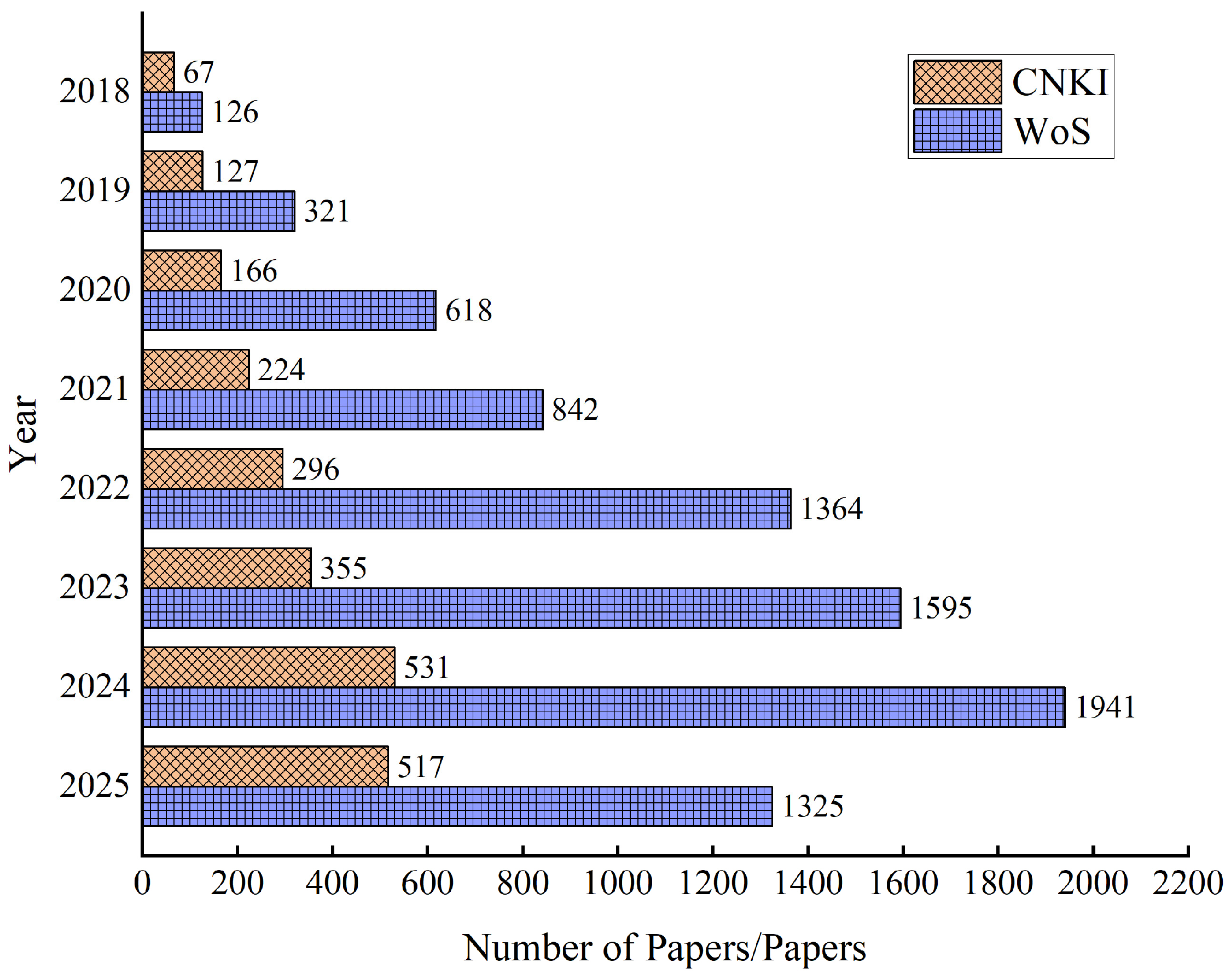
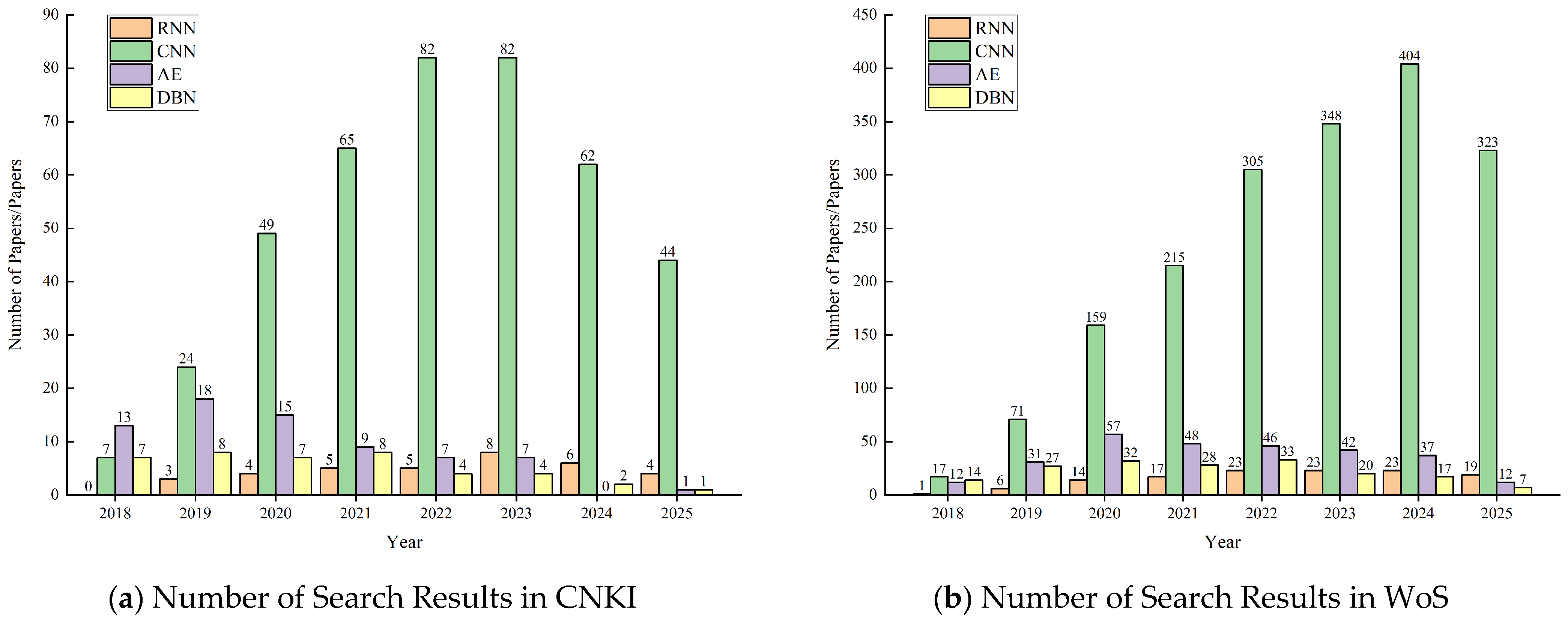
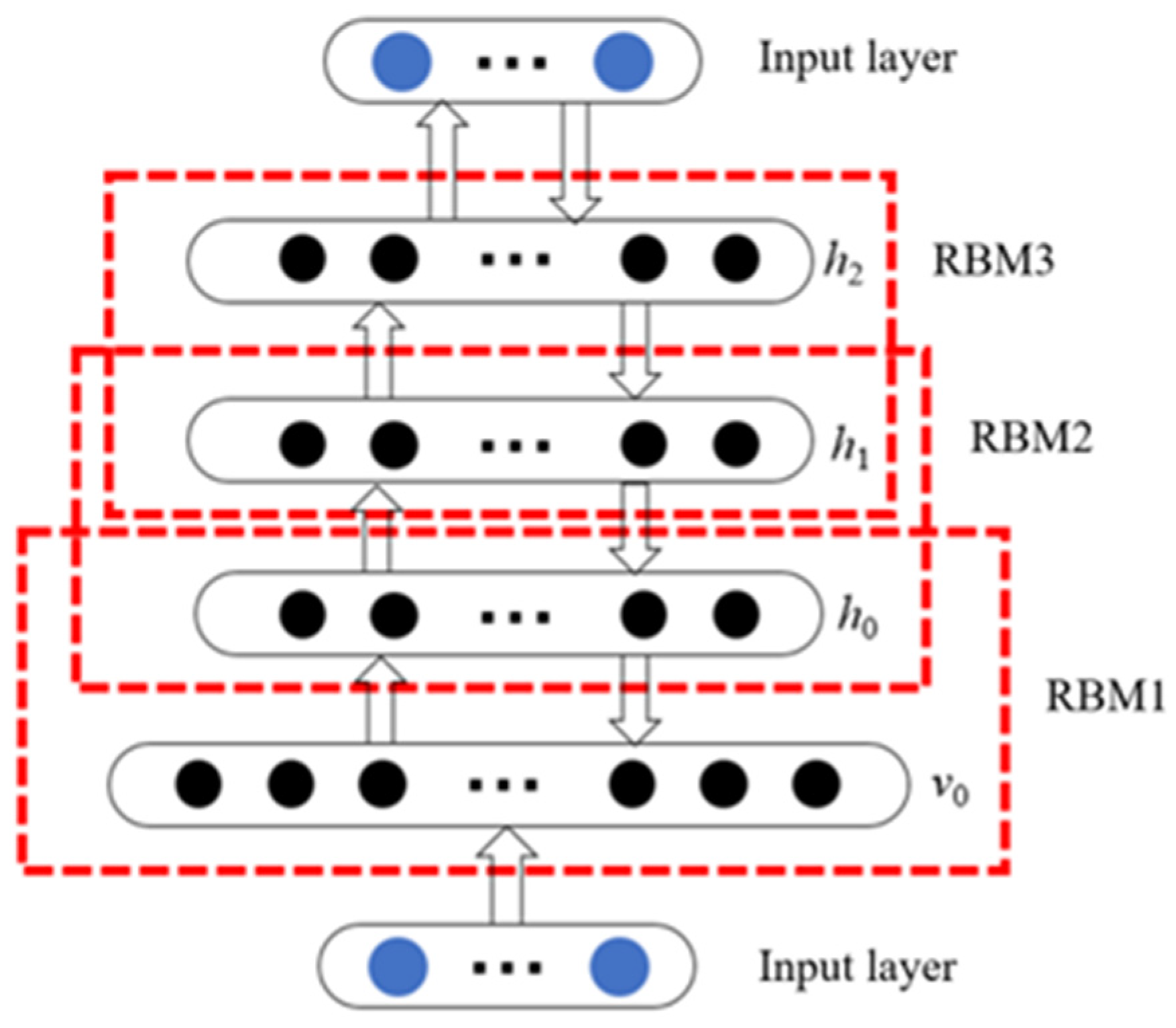
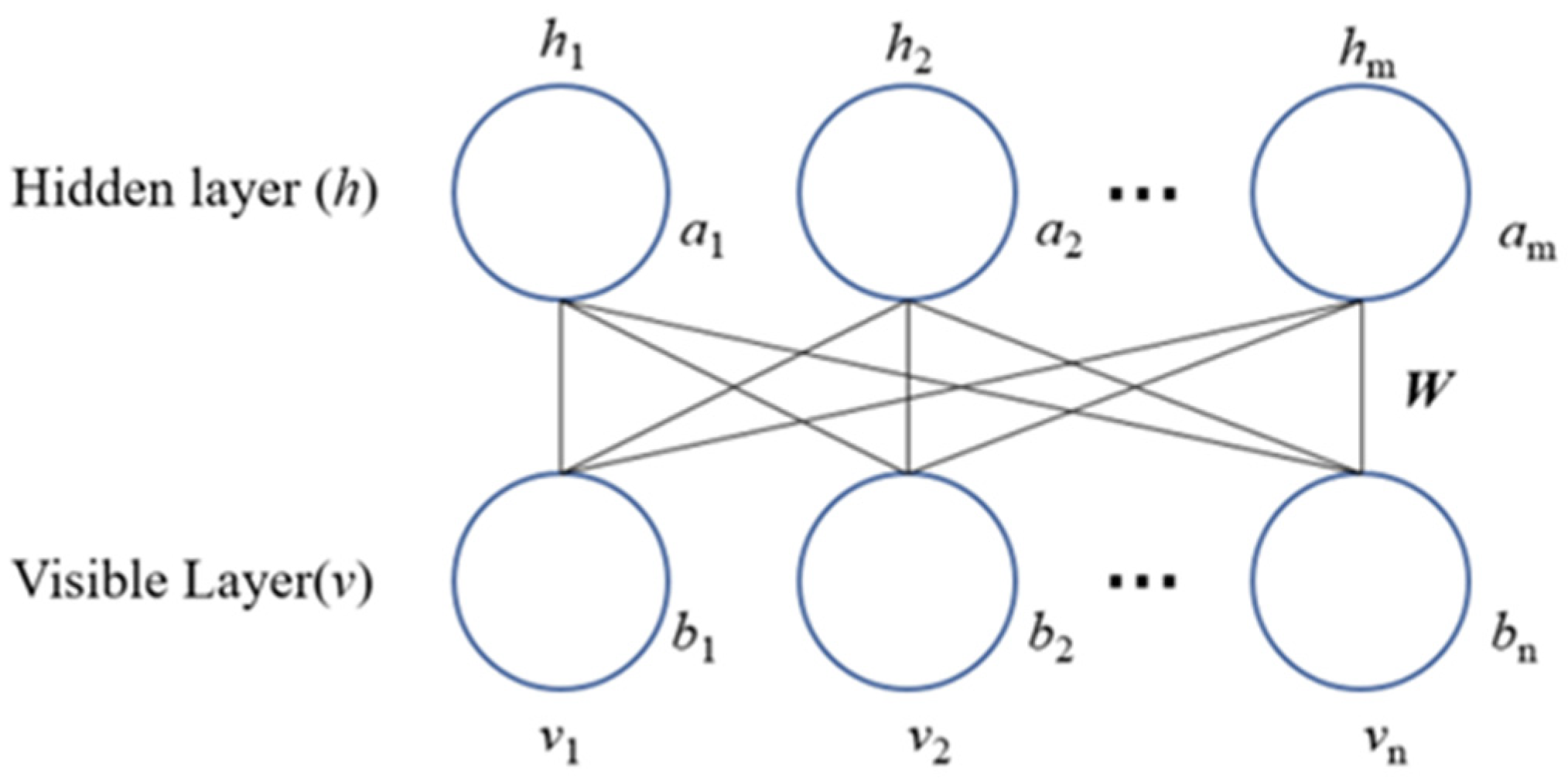
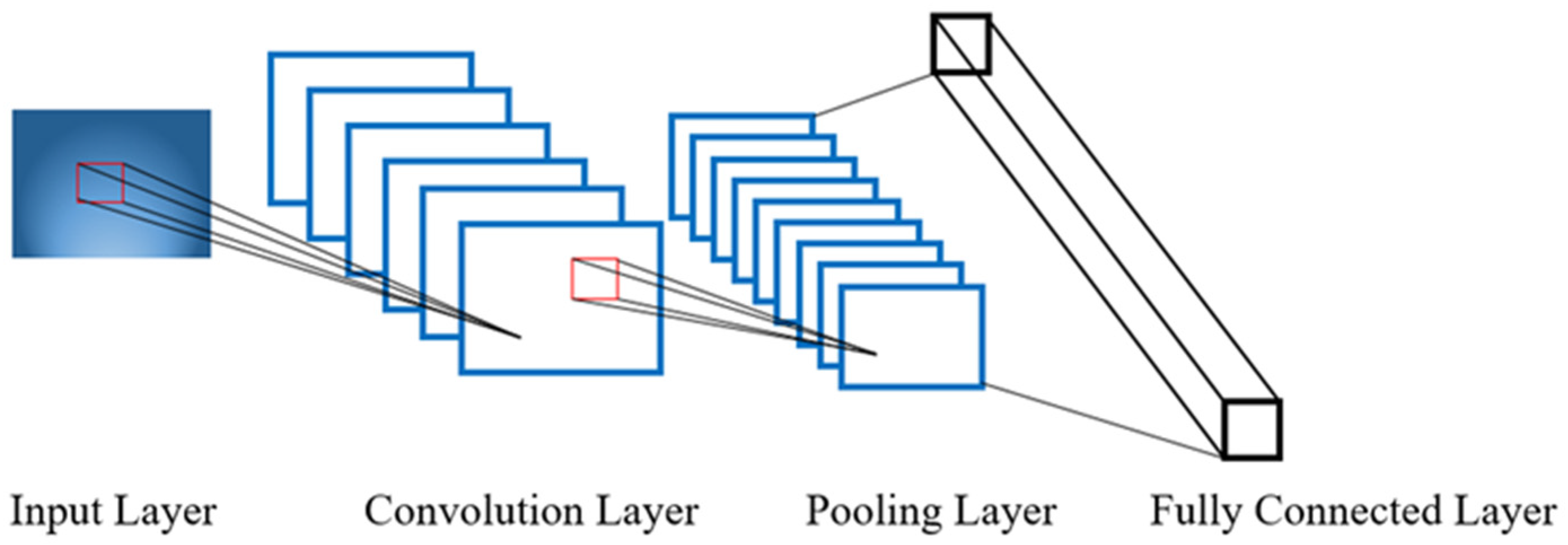
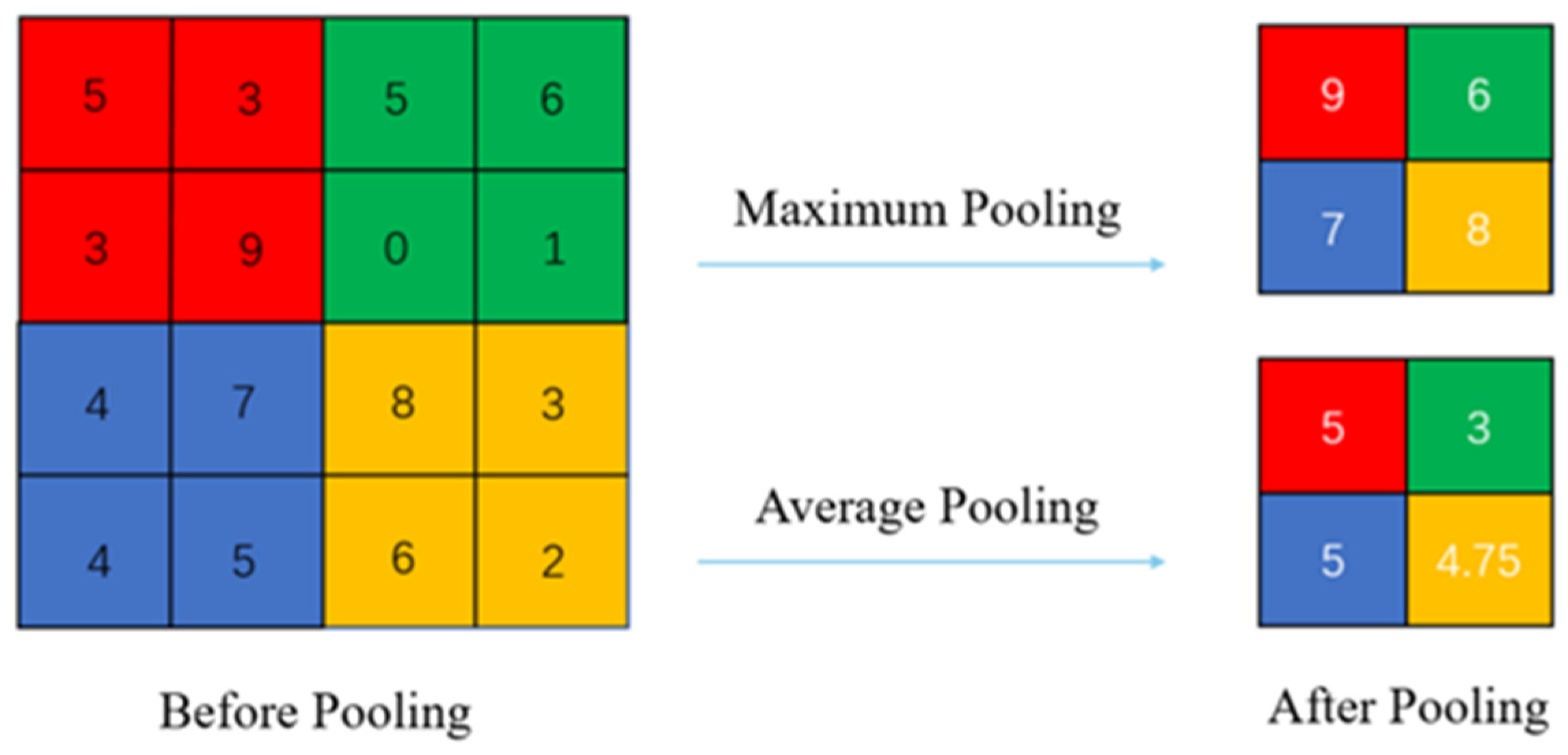
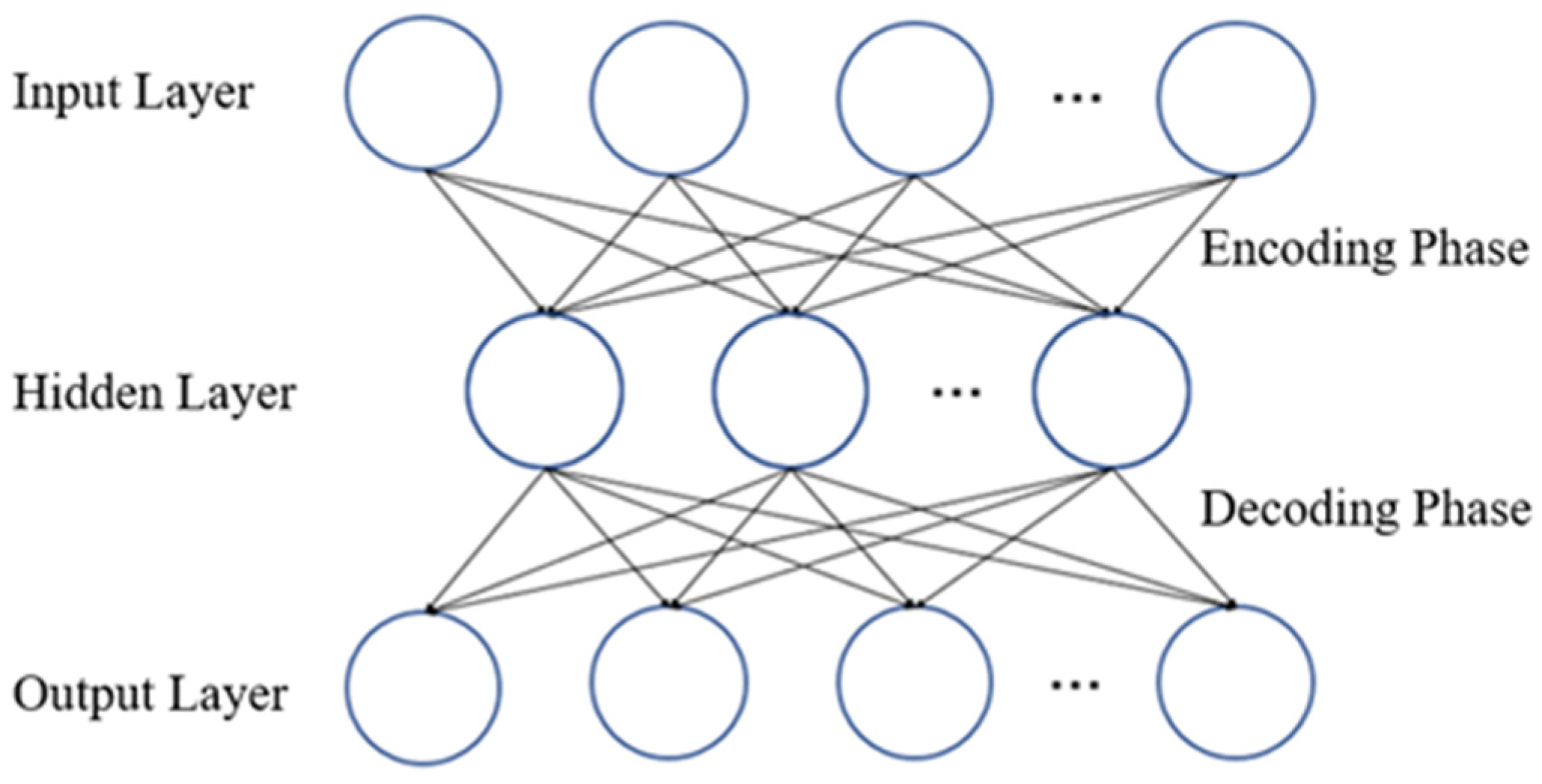
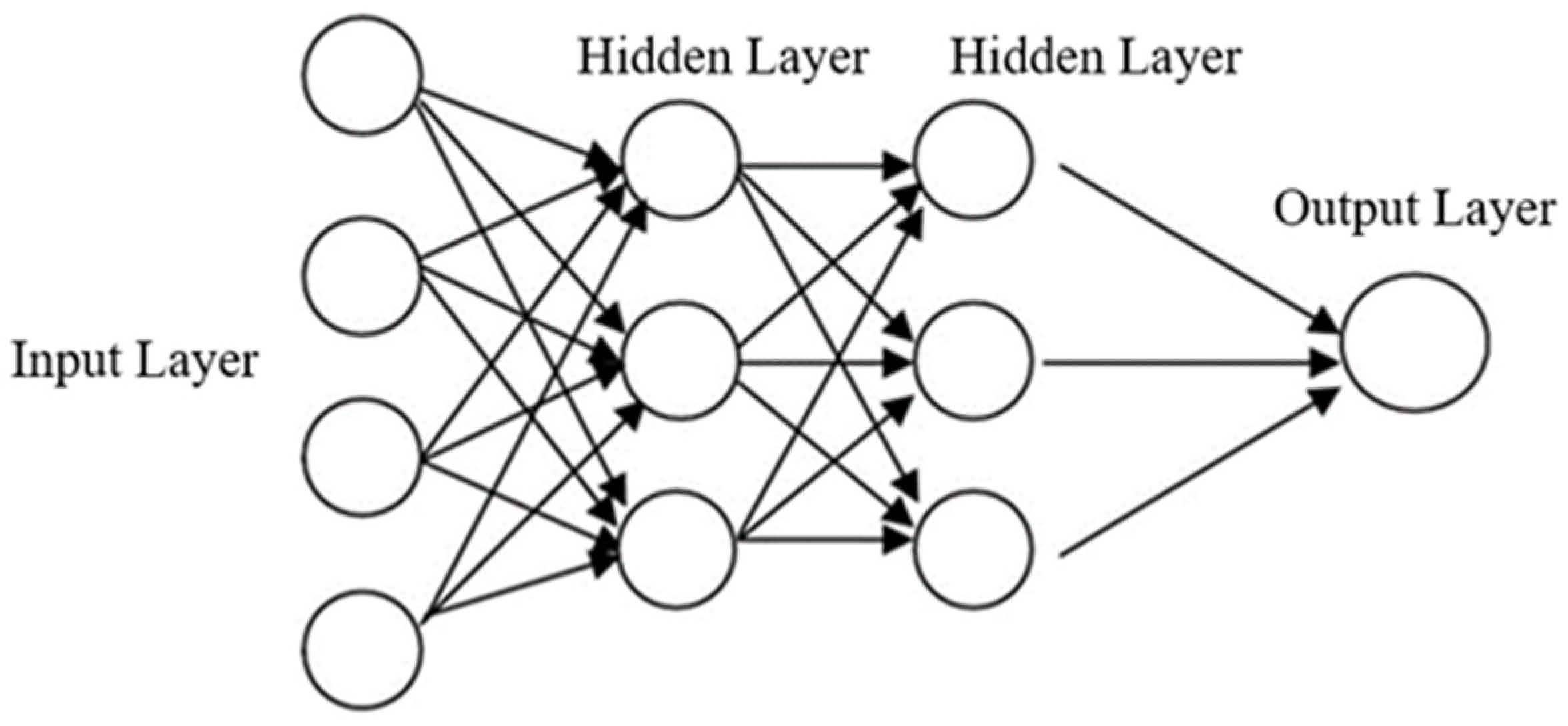
| Method | Core Principle | Advantages | Limitations | Applicable Scenarios |
|---|---|---|---|---|
| STFT | Window-Added Fourier Transform | High computational efficiency | Fixed window length, limited time-frequency resolution | Steady-state operation monitoring |
| WT | Small-waveform analysis | Multi-resolution, transient-sensitive | High computational complexity, basis selection sensitivity | Impact fault diagnosis |
| EMD | Adaptive Signal Decomposition | Requires no basis functions, highly adaptive | Modal aliasing, end-point effects | Non-stationary signal analysis |
| VMD | Variational Framework Decomposition | Avoids modal overlap, high accuracy | Significant impact of parameter selection | Composite feature separation |
| HHT | Combining EMD with Hilbert Transform | High-resolution time-frequency representation | Computational complexity, boundary effects present | Nonlinear, non-stationary signals |
| Dimensions | RNN | CNN | AE | DBN |
|---|---|---|---|---|
| Core Principles | Sequential modeling, memory function | Spatial feature extraction | Data compression and reconstruction | Unsupervised pre-training, hierarchical learning |
| Applicable Data | Time Series | Time-Frequency Images | One-Dimensional Signals | One-Dimensional Vibration/Spectrum |
| Computational Efficiency | Complex training, high inference resource | Efficient and easy to deploy | Moderate training, fast reasoning | Time-consuming training, relatively fast inference |
| Noise Resistance | Sensitive, with filtering effect | General, can enhance | Excellent, can eliminate noise | Fairly good, relatively robust |
| Application Potential | Predictive Maintenance, Lifespan Forecasting | Visual fault recognition | Abnormal detection, status monitoring | Early Warning, Small-Sample Learning |
Disclaimer/Publisher’s Note: The statements, opinions and data contained in all publications are solely those of the individual author(s) and contributor(s) and not of MDPI and/or the editor(s). MDPI and/or the editor(s) disclaim responsibility for any injury to people or property resulting from any ideas, methods, instructions or products referred to in the content. |
© 2025 by the authors. Licensee MDPI, Basel, Switzerland. This article is an open access article distributed under the terms and conditions of the Creative Commons Attribution (CC BY) license (https://creativecommons.org/licenses/by/4.0/).
Share and Cite
Wang, H.; Wang, H.; Tang, X. A Review of Deep Learning in Rotating Machinery Fault Diagnosis and Its Prospects for Port Applications. Appl. Sci. 2025, 15, 11303. https://doi.org/10.3390/app152111303
Wang H, Wang H, Tang X. A Review of Deep Learning in Rotating Machinery Fault Diagnosis and Its Prospects for Port Applications. Applied Sciences. 2025; 15(21):11303. https://doi.org/10.3390/app152111303
Chicago/Turabian StyleWang, Haifeng, Hui Wang, and Xianqiong Tang. 2025. "A Review of Deep Learning in Rotating Machinery Fault Diagnosis and Its Prospects for Port Applications" Applied Sciences 15, no. 21: 11303. https://doi.org/10.3390/app152111303
APA StyleWang, H., Wang, H., & Tang, X. (2025). A Review of Deep Learning in Rotating Machinery Fault Diagnosis and Its Prospects for Port Applications. Applied Sciences, 15(21), 11303. https://doi.org/10.3390/app152111303





